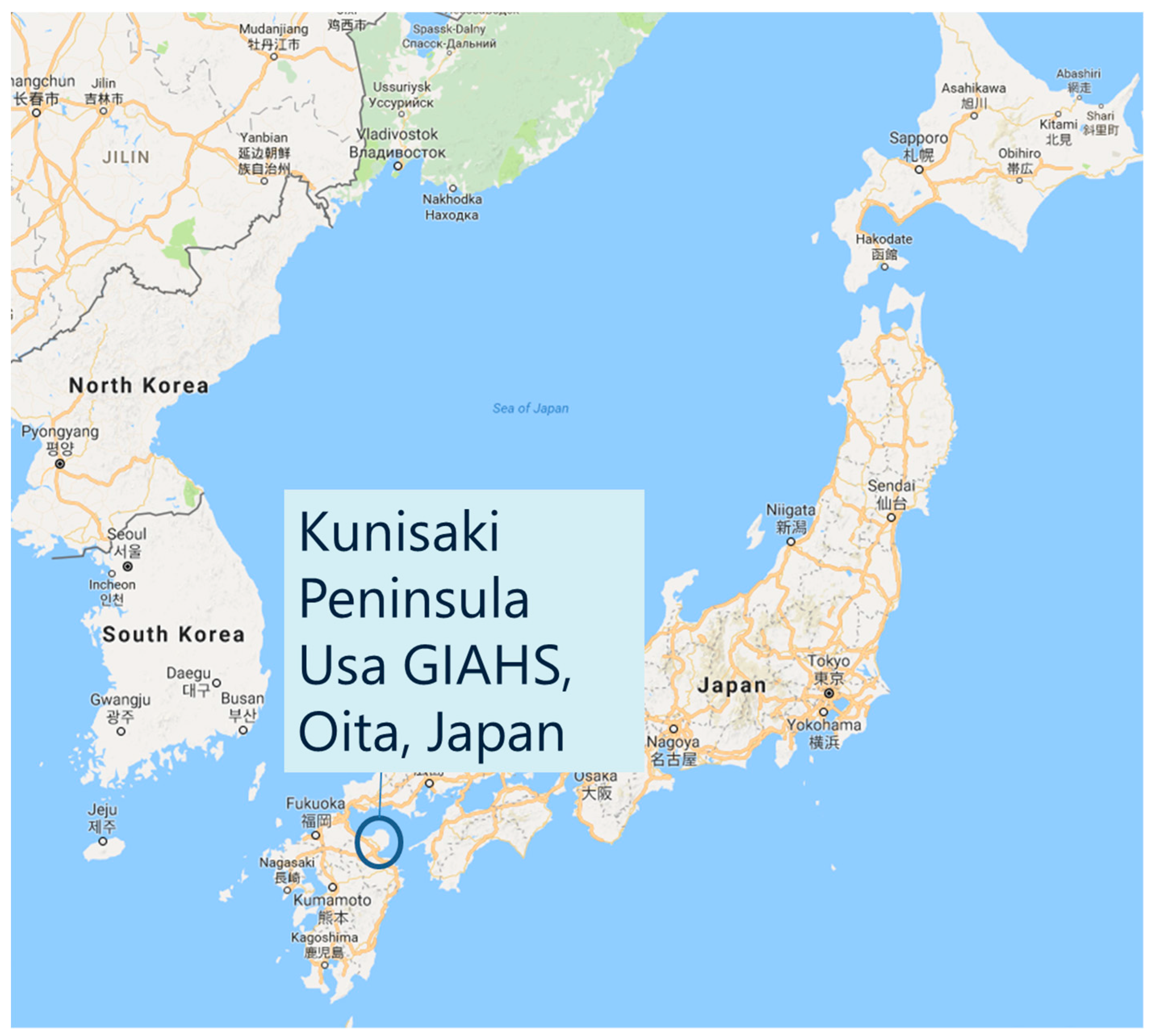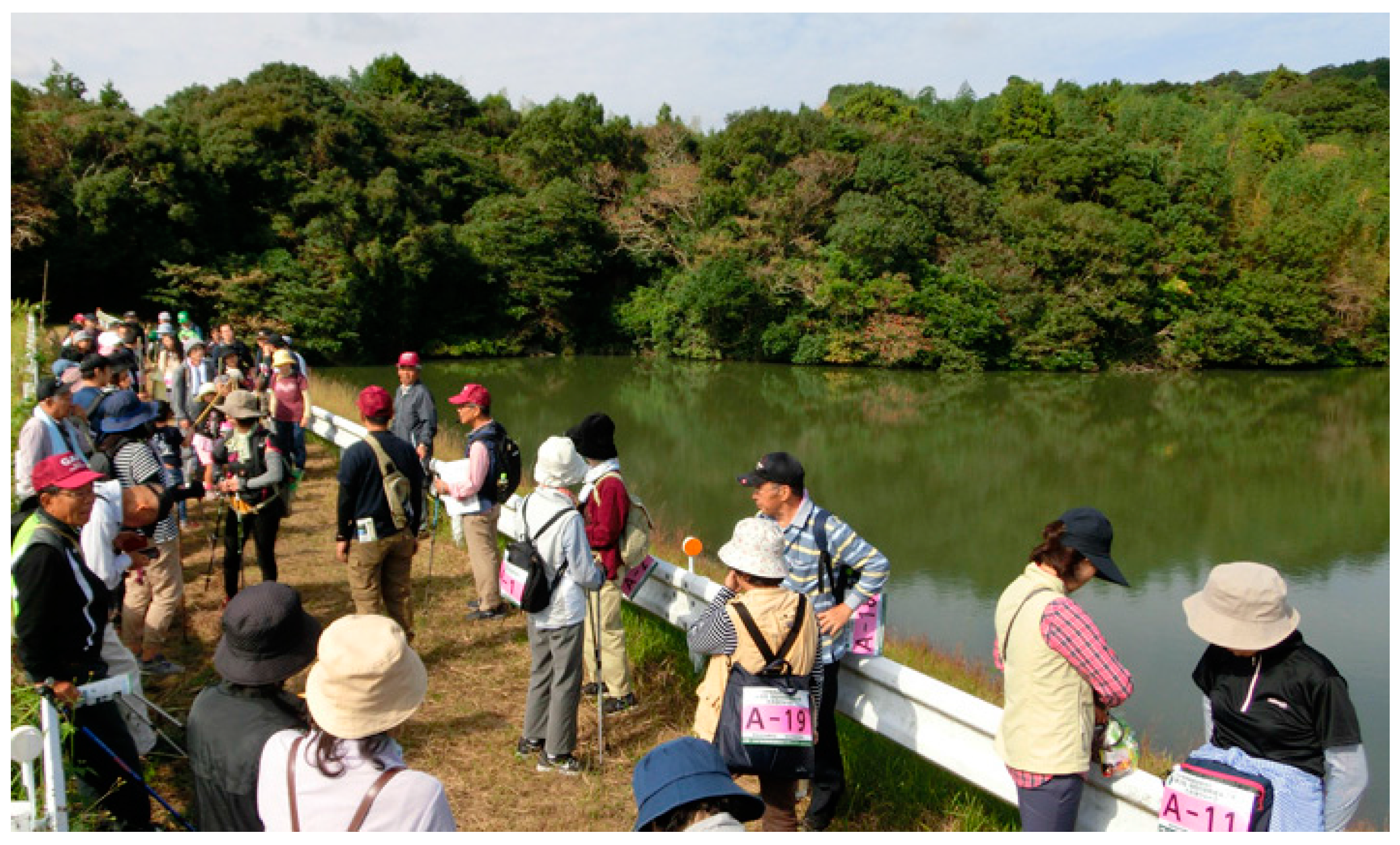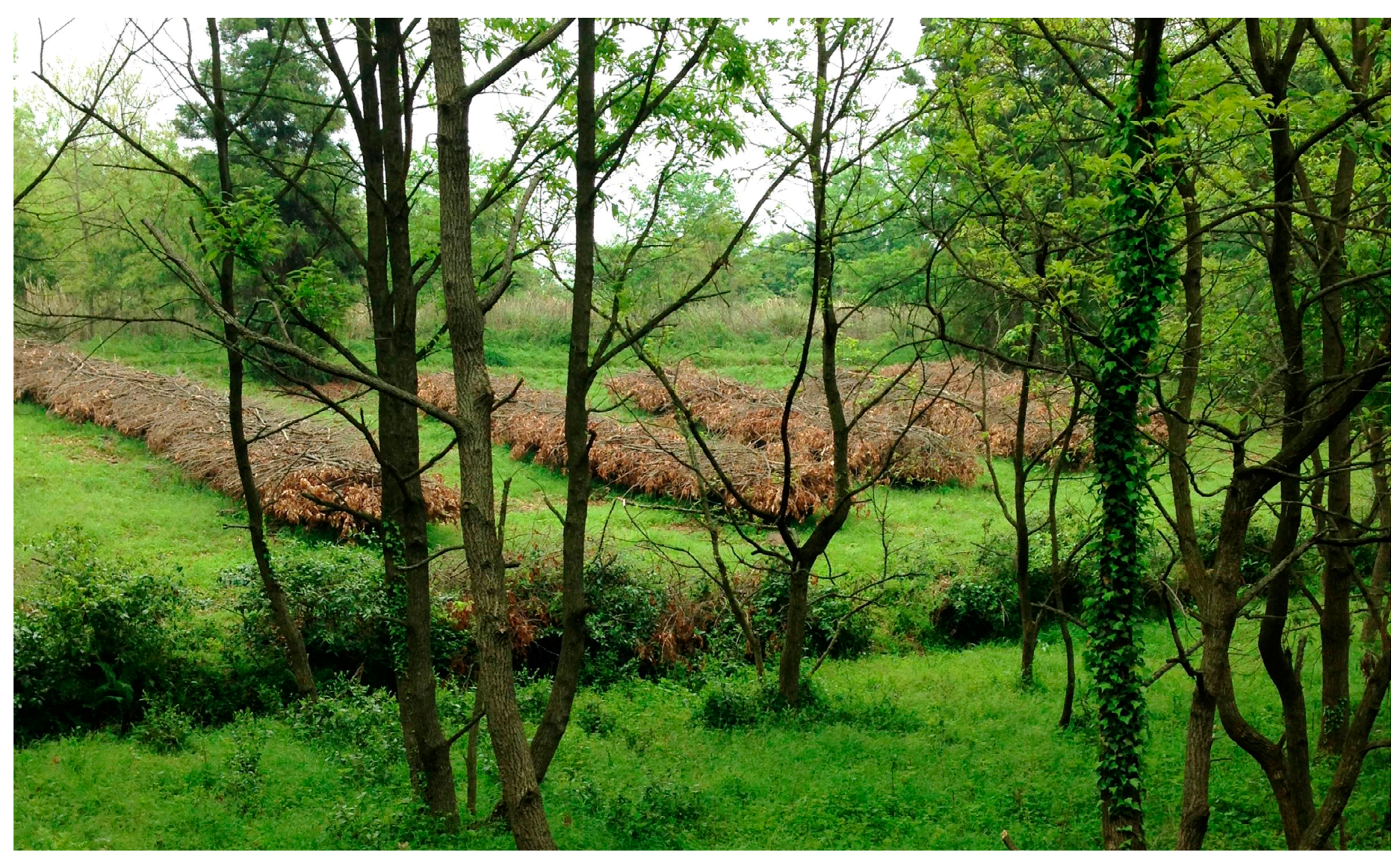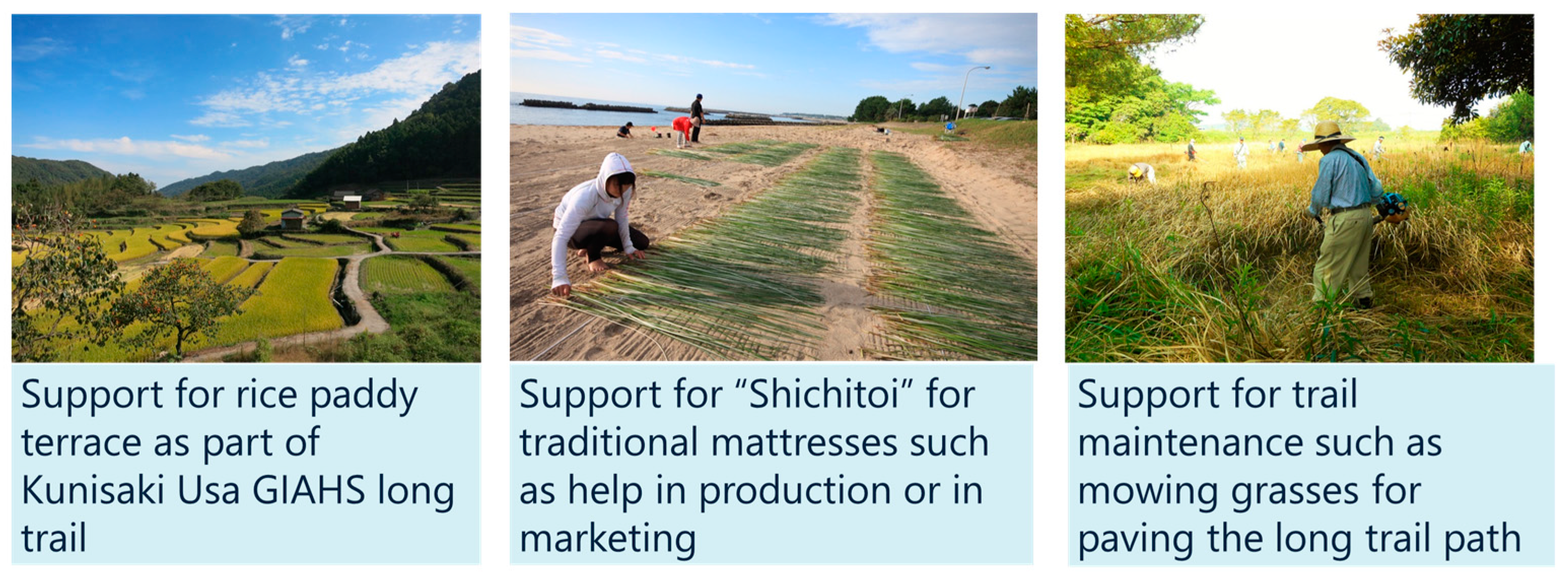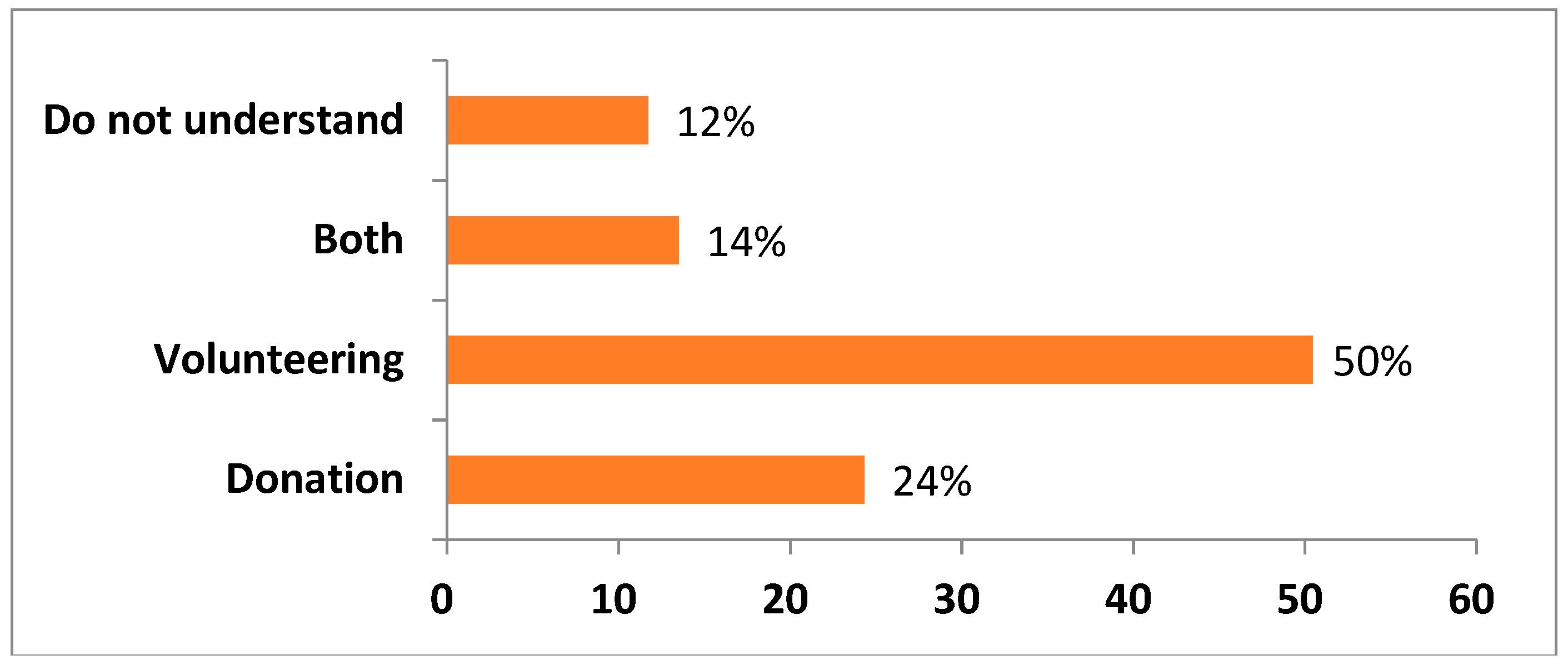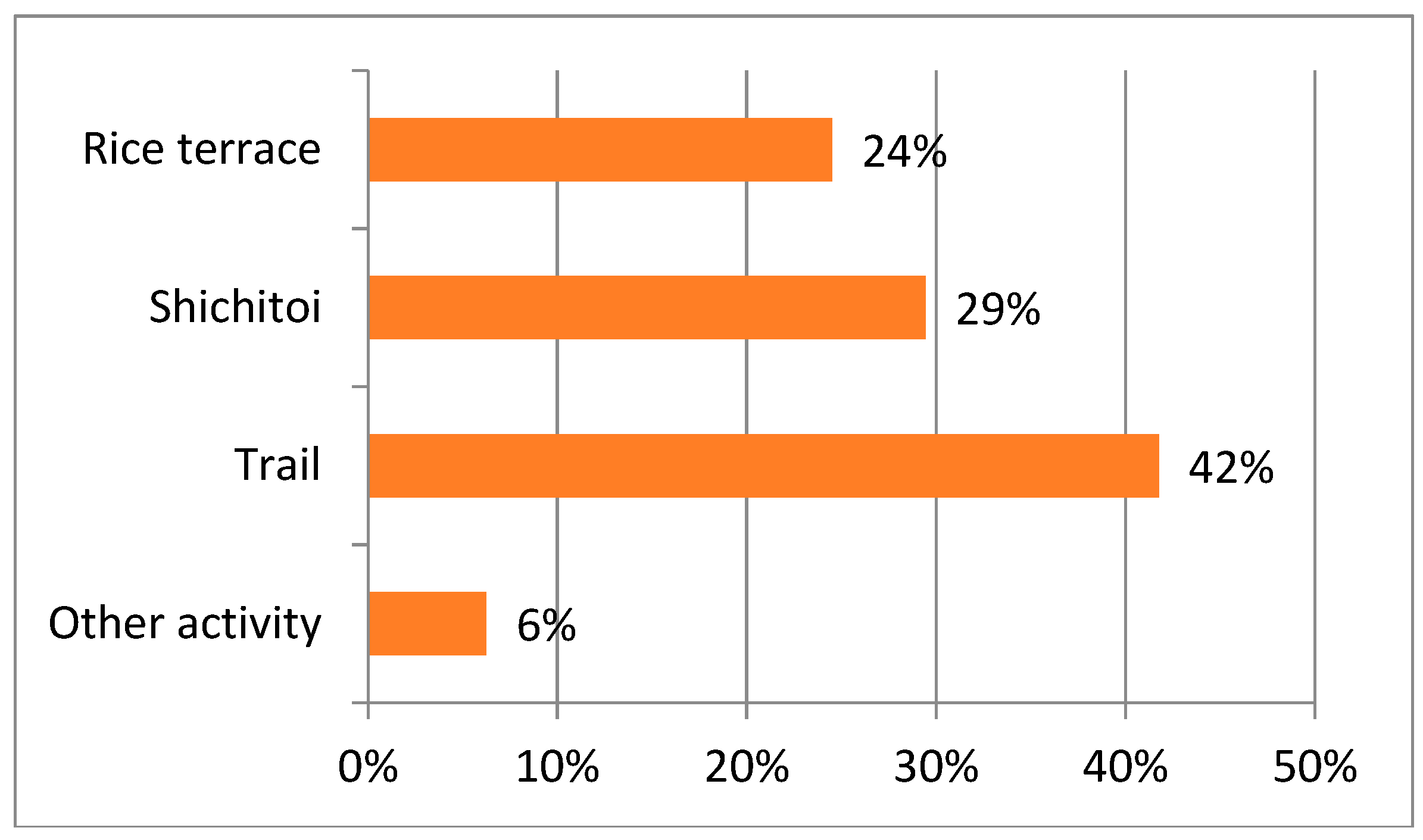1. Introduction
The provision of ecosystem services from regions that are influenced by the practice of agriculture are often considered as public goods, including biodiversity and rural cultural landscapes [
1,
2]. In the past, the maintenance of public goods required the support of public institutions. However, the Payment for Environmental Services (PES) mechanism where a user pays principle or payment from the beneficiaries proposes that payments are made to farmers, landowners, or other entities who provide environmental services by agreeing to manage natural resources in a certain way [
3]. PES has been used to stand for Payment for Environmental Services or Payment for Ecological Services interchangeably; however, we adopt the definition of PES as payment for environmental services that comprise the benefits associated with different types of actively managed ecosystems, such as sustainable agricultural practices and rural landscapes as defined by Muradian et al. [
4].
Along with the spread of the PES concept, conservation activities by a variety of entities have also been promoted. Private sector PES is considered to be the promotion of conservation for public good involving entities other than a governmental body or those funded by the government. It is recognized as a joint approach whereby the government and the private sector together support public goods [
5,
6]. Both World Heritage sites designated by the United Nations Educational, Scientific and Cultural Organization (UNESCO) and Globally Important Agricultural Heritage Systems (GIAHS) designated by the Food and Agriculture Organization (FAO) contain elements of landscapes and seascapes features as well as agro-biodiversity as part of environmental conservation and conservation of agricultural cultural systems. Conservation activities by diverse entities are important concepts in the management of both types of heritage sites.
For the government, the main measures for the provision of environmental services on farmland are agri-environmental payment schemes, which can be effective if well-designed and well-targeted [
7], as well as organic labelling schemes to correct environmental externalities in agriculture [
8]. When we examined the existing agri-environmental policy in Japan, we found there was growing recognition of farmland agro-biodiversity and rural landscapes as parts of environmental services, accompanied by efforts to support them [
9]. The Direct Payment for Hilly and Mountainous Areas introduced in 2000 was introduced for supporting predominantly less favorable areas. However, the Payment for Agricultural Land and Water Conservation Management (formerly Measures to Conserve and Improve Land, Water, and Environment) was introduced in 2007 in recognition of conserving GIAHS-related features. In 2011, Direct Assistance for Environmentally Friendly Agriculture recognized the importance of the conservation of agro-biodiversity for the first time [
9]. The most recent agri-environmental policy related to farmland biodiversity in Japan was the Act on the Promotion of Realizing Multifunctional Role of Agriculture introduced in 2014 [
10].
However, conserving agricultural and cultural systems is not the main objective of agri-environmental schemes, although it is partially or indirectly related. The most important purpose of GIAHS is to bequeath its value, knowledge, and culture to the next generation. Unlike the World Heritage sites of UNESCO that preserve culturally or physically significant places, the purpose of GIAHS is the maintenance and succession of “living” agricultural and cultural systems, which are still maintained and passed down through people’s activities. If we do not act to conserve these systems, it is easy to imagine that they might disappear. This requires a mechanism to support the activities of rural people that shape features of GIAHS locations. Therefore, Japan’s agricultural environmental policy requires a PES mechanism where we manage, inherit, and evolve agricultural and cultural systems.
The aim of this research was to develop a support mechanism for GIAHS. We investigated support for different conservation activities as well as the implications of providing options for activities to manage GIAHS-related trails in Kuinsaki-Usa GIAHS, thus aiding the continuation of Japan’s original farming cultural systems. In this paper, we first propose a tourism model for regional promotion with footpaths as the main axis in the “Agri-culture System” designated as part of GIAHS. We provide a case study of the Usa area of Oita Prefecture which is a GIAHS site with the concept of resource circulation [
11].
Second, we explored the management methods as well as the use practices of the footpaths for their future conservation. To help with the management, maintenance, and repair of sustainable trails, we need to consider alternative sources of assistance apart from government subsidies, including private resources with non-governmental support measures. Thus, we applied techniques from environmental resource economics to evaluate the multi-faceted economic value of the footpaths. Then, we explored the sustainable management support measures for the footpaths that were commensurate with their value.
2. Footpaths as the Main Axis in the “Agri-Culture System”
The farmed countryside has been recognized as a multifunctional space, with its real economic value being more than just agricultural production [
2,
12]. Through walking, we can absorb and observe the facets of farming culture and its history. When we walk in the countryside, we may discover things about the area that would be missed if we had driven through in a car. A footpath also provides several services and functions. Walking provides multiple benefits [
13]. Studies have shown that there is evidence of medical and health benefits associated with walking groups [
14]. Exercising in nature can also promote psychological benefits [
13]. Apart from providing health benefits, footpaths also harbor rare plant species along their boundaries, reflecting harmony between nature and human activities. Finally, if a footpath is maintained well, it indirectly generates revenue for the rural economy. Thus, having a footpath can provide an additional attraction and income source for the rural economy.
As Vafadari [
11] describes, the Kunisaki Peninsula Usa GIAHS which is located in Oita, Kyushu, the Southwest of Japan (
Figure 1), features resource circulation with the use of agroforestry where shiitake mushrooms are produced in deciduous Sawtooth Oak (Q
uercus acutissima) forests with the largest growth rate in Japan. Local farmers have always faced a lack of water in the area. Eventually, the farmers overcame the problem by interlinking multiple irrigation reservoirs. The communities with access to irrigation provided water to the villagers in the coastal community, which had no access to irrigation, and in return, the shore community provided the community with reservoirs with access to the shore where they could lay out and dry Shichitoi (
Cyperus monophyllus Vahl) on beaches. Shichitoi is the raw plant material for traditional mattresses produced only in this part of Japan and which forms an important cash crop for the region. Over time, the interlinked systems of Japan’s greatest area of Sawtooth Oak forests and multiple irrigation reservoirs have facilitated a variety of agriculture, forestry, and fishery industries, which includes the country’s sole Shichitoi production. These systems have allowed the rural economy to flourish as well as preserving the diverse ecosystems.
The Minemichi Long Trail in the Kunisaki Peninsula-Usa GIAHS was designated as an official trail by the Japan Trail Council in 2013. The Long Trail is a nature footpath that includes mountain paths and ancient roads while exploring GIAHS features. Walkers can tackle parts of or the whole trail to enjoy the local nature and culture, while connecting with the people of the area. Kunisaki Peninsula has long been a site for temples, termed the “Rokugo Manzan”, which is the generic term for the large and small temples built there by the same religious sect. Rokugo refers to the six towns established along the valleys extending from Mt. Futago, which stands in the center of the region. The monks of the Rokugo Manzan temples have long practiced “mineri”, which is the act of traversing rough terrain for ascetic training using the mountain trails around the Kunisaki Peninsula. These trails have been reconstructed and serve as the foundation for the Minemichi Long Trail. The GIAHS trails are part of this network, with a total length of about 135 km. Kunisaki is the birthplace of the syncretism of Shintoism and Buddhism where some of the unique original landscape of Japan remains. It is a trail packed full of GIAHS features, encompassing Kunisaki’s cultural and natural history through the Sawtooth Oak forests and reservoirs of the GIAHS of the Kunisaki Peninsula Usa area, the Rokubo Manzan temples, and the scenic views of the Seto Inland Sea National Park.
The footpath could be a new axis in the rural development of the region to provide a tourism model for regional promotion. The Long Trail contains multi-functional components of GIAHS such as cultural landscapes, traditional agriculture, agricultural culture, regional food, and biodiversity. The multifunctionality of long trails could attract Japanese and overseas tourists equally as walking in the countryside is becoming popular in Asia. Many GIAHS-themed walking events are organized by various local communities in the Kunisaki and Usa regions throughout the year (
Figure 2). The long trails are part of the Satoyama, Japanese commons, which are managed by the local community. Therefore, the maintenance of such trails is the responsibility of the locals.
At present, the development of sustainable management and use practices for trails are at an initial stage. This study explores possible conservation management systems to promote sustainable tourism on trails and footpaths. We conducted a questionnaire-based survey of people participating in walking events, saying that local groups and citizens were intending to work on activities to maintain and protect the GIAHS sites through selling traditional items such as souvenirs and mowing walking tracks to maintain footpaths.
In the same area, the surrounding forests are “Hoda-ba”, the storage areas where Sawtooth Oak is dried and laid for the fermenting process, which creates high-quality Shiitake mushrooms, the local specialty agricultural forest product in this region (
Figure 3).
3. Methods
Support for conservation activities can be achieved by people spending their time as volunteers for those activities. Recent studies have shown the plausibility of using labor contributions as a payment vehicle in contingent valuation (CV) surveys [
15]. The present study adopted the Willingness to Contribute in Labor (
WTCL) approach. In this paper, although we show the WTP in labor terms, here in the methods, the results show WTP in labor terms as a volunteer. The theoretical framework of using time as a payment vehicle for CV studies is based on the notion of a time-compensating surplus, which is analogous to a compensating surplus measure of monetary WTP [
16]. Based on this framework, welfare estimates for keeping the current level of GIAHS quality can be expressed as
where the indirect utility function
. denotes the amount of time a respondent is willing to contribute to labor
. for the proposed activities supporting GIAHS features and can be used to provide a change in environmental service provision, from no provision by non-government support
. to an improved environmental service provision through the support of other entities
. When a person agrees to take part in activities that promote conservation, that person has less time available for other activities. Thus, the labor time contribution to the proposed program represents a payment and involves a reduction in the respondents’ time budget
available for other activities (work or leisure). The variable
. represents the vectors of the socioeconomic variables that vary across the respondents.
In this survey, an open-ended CV format was used to elicit each respondent’s
WTCL. This elicitation format has several advantages. First, it reduces the time and expense of the survey process when we are taking up the walker’s time during their walking activity. Second, bid ranges can fall within a narrow range of low values. Finally, the amount of starting-point bias may be negligible. The last advantage is particularly important as it is not easy to provide a starting-point for volunteering for conservation activities in each specific case. However, a common drawback of this format is the generation of a considerable number of zero responses [
17]. Since Tobit analysis is the more theoretically correct method for willingness-to-pay (WTP) data sets with large numbers of zero bids, a linear specification of the model was performed using Tobit regression. Tobit regression has advantage of taking into account the difference between censored (zero) and continuous observations in the process of estimation, leading to more consistent parameter estimates [
18]. The Tobit regression can be generally expressed as follows [
19]:
where
. is an unobserved continuous dependent variable,
is a vector of explanatory variables,
β is a vector of coefficients,
is an independently distributed error term assumed to be normal with a zero mean and constant variance
σ2, and
i = 1, 2, …,
n denotes individuals in the sample. The observed
WTCL variable takes the following form:
We conducted the survey from 28 October 2016 to 23 April 2017. We interviewed 283 Kunisaki trail walkers and recovered 266 questionnaires (return rate of 93.9%).
Walking participants were asked whether they were willing to conserve the Kunisaki-Usa GIAHS site and what their WTP would be in terms of labor hours by volunteering to support conservation activities related to the GIAHS, namely, support for the Mitsujyoin Paddy Rice Terrace (rice activity), support for traditional Shichitoi production or its marketing (Shichitoi activity), or support for the maintenance of the Long Trail such as mowing by local communities (walk activity) (
Figure 4). The sample size was 230 for the analysis. The versions of questionnaire were (1) all activity options available; (2) support for rice paddy terrace only; (3) support for Shichitoi only; and (4) support for trail maintenance only, and their sample sizes were 84, 48, 50, and 48, respectively (
Table 1). We analyzed the data using Nlogit ver. 5.0, Econometric Software, Inc. (Plainview, NY, USA).
The sampling distribution is shown in
Table 1.
As shown in
Table 2, the distribution of labor contributions ranged from 0 to 8 h per year. The average labor contribution was 3.69 days per year. About 44% of the respondents were male and the average age of the respondents was 52.62 years old. Among respondents, 28% were from Oita Prefecture (not including Kunisaki people), 69% were from the Kunisaki Peninsula, and the remaining 10% were from outside Oita. The average number of visits to Kunisaki was 2.82 times per year and the average time of travelling to Kunisaki was 0.91 h (54.6 min). The average number of people walking together as a group was 4.18, and 7% of the respondents were farmers. About 24% of the respondents received a version of questionnaire with rice activity as a support option, 0 if not. Around 32% of the respondents had received a version of questionnaire with Shichitoi activity as a support option, 0 if not. Finally, 47% of respondents had received a version of questionnaire with walk activity as a support option, 0 if not.
In
Appendix A, we attach the questionnaire addressing the walk participants’ willingness to support and their elicited values for activities supporting GIAHS features in Oita, Japan.
4. Results
We asked questions to elicit people’s awareness level about the multifaceted constituent elements of GIAHS, such as cultural landscapes, traditional agriculture, agricultural culture, food, and biodiversity, which together form the attractions of the trail. For this reason, the participant’s level of knowledge about GIAHS was sought as follows: “Do you know that GIAHS is composed of five elements: cultural landscape, traditional agriculture, agricultural culture, food, and biodiversity?” Of the responses, 25% were familiar, and 58% were somewhat familiar with the components of world agricultural heritage. However, 16% of the participants did not know about the components of world agricultural heritage. These respondents may object to donating or volunteering because the reason for supporting GIAHS features is vague.
The reason why the knowledge of world agricultural heritage was high among the walk participants may be that, during the walk, people from local communities guide the way. The guides take walkers to the reservoirs and the storage areas for Sawtooth Oak for shiitake mushroom production that is a constituent element of the Kunisaki-Usa GIAHS. The guides also talk about the historical background of traditional agriculture in the Kunisaki Peninsula. Therefore, while enjoying walking in the cultural landscape, there are opportunities for walk participants to learn about traditional agriculture, and to appreciate agricultural culture, food and biodiversity. Walking is different from, for example, a lecture as it is an advantage to learn the value of the GIAHS while experiencing its elements with all five senses. The experiences of walking are an effective way to promote the value of the GIAHS and the necessity of maintaining and inheriting it.
The results of the questionnaire showed that 76% of walking participants wanted to support conservation activities (
Figure 5).
Among them, 50% liked to provide support by volunteering, 24% by donation, and 14% by both donation and volunteering (
Figure 6).
Then, we explored support for the variety of GIAHS-related trail conservation activities, namely support for paddy terracing, Shichitoi promotion, and trail maintenance. Approximately 42% of respondents preferred to support trail maintenance, while 29% and 24% preferred to support Shichitoi and paddy terracing, respectively (
Figure 7).
When people had options to choose walk supporting activities, such as track maintenance and mowing (
OPTIONWALK), they were willing to contribute more volunteering time than those who did not have this option but walk as a supporting activity while other options (
OPTIONRICE and
OPTIONSHICHITOI) did not show a difference in willingness to contribute depending on the option availability. The respondents’
WTCL in volunteering was 4.23 days/year among people who had options to choose walk supporting activities (
OPTIONWALK) and 3.34 days/year among people with no choice. There was no clear difference in volunteering in days when respondents had options to choose their supporting activities for rice terrace activities, 3.90 days/year among with-option people and 3.72 days/year among non-option people, nor was there a clear difference for Shichitoi promotion activities, 3.70 days/year among with-option people and 3.64 days/year among non-option people (
Figure 8).
Table 3 presents the results of the Tobit regression analysis of the factors affecting
WTCL for the proposed activities supporting GIAHS features. Model 0 included the all participants of walks. In Model 0, the coefficients for
VISIT,
PEOPLE, and
FARMER were statistically significant. For those who had one additional visit to Kunisaki Peninsula (
VISIT), there was a 0.506 day (12.14 h) a year increase in the predicted value of
WTCL. Also, each one person increases in those who participated together (
PEOPLE) was associated with a 0.103 (2.47 h) a year increase in the predicted value of
WTCL. The predicted value of
WTCL increased by 1.669 days a year for those who were farmers (
FARMER = 1) than for non-farmer participants (
FARMER = 0).
Model 1 included only those who could see the rice support activity as their choice of support option. In Model 1, the coefficients for DOITA and DKUNISAKI were statistically significant factors affecting WTCL. The predicted value of WTCL was 5.586 days fewer for those who were from Oita (DOITA = 1) than for participants from outside Oita (DOITA = 0). Similarly, the predicted value of WTCL was 5.425 days fewer for those who were from Kunisaki Peninsula (DKUNISAKI = 1) than for participants from outside Kunisaki (and also not from Oita) (DOITA = 0).
Model 2 included only those who could see the Shichitoi support activity as their choice of support option. In Model 2, the coefficients for PEOPLE were statistically significant. Finally, Model 3 included only those who could see a walk support activity as their choice of support option. In Model 3, the coefficients for PEOPLE and OPTIONWALK were statistically significant. Each one person increases in those who participated together was associated with a 0.154 day (3.7 h) a year increase in the predicted value of WTCL. Also, for OPTIONWALK, the predicted value of WTCL was a 1.146-h increase for those who had a support activity for walk in their support options besides support for the rice activity. From Model 0 to Model 3, other socio-economic variables such as GENDER and AGE were not statistically significant (p > 0.10) in explaining the dependent variable.
5. Discussion
The focus of the discussion is on the elicited value of volunteering to support GIAHS activities. In Model 0, which included all the participants of walks,
VISIT,
PEOPLE, and
FARMER are statistically significant. The positive impact of
VISIT on the contribution in labor time was in line with the finding of Chen and Liaw [
20] in their value study of forested trail eco-tourism values. The more times that people visited a place, the higher their willingness to pay. Also, the positive effect of
PEOPLE on the contribution in labor time confirmed the findings of Marselle et al. [
21] in the efficacy on the mental, emotional, and social well-being benefits from participating in group walks in nature. The result of
FARMER showed that those who were currently FARMERs or used to be FARMERs had a higher willingness to contribute in volunteering. The elicited value in terms of labor as a volunteer to assist activities showed that participants who were farmers were willing to contribute 1.669 days per year more compared to non-farmer participants to support activities for the GIAHS experience. When we introduced the with-options or without-options for supporting activities, we saw a slightly different picture. This might reflect the fact that farmers understood the importance of landscape maintenance or community support to manage these conservation activities.
From Model 1, for the rice activity, people participating in walking from outside the Prefecture and outside the Peninsula indicated that they were more willing to support agricultural heritage through volunteering than those inside the Peninsula at the 5% significance level. This was also found in Chen and Liaw [
20], where years living in the community had a negative impact on the willingness to pay among residents. This is plausible because we would expect more people from outside to appreciate what Kunisaki can provide when they visit and be more willing than those inside the Prefecture. It might be because those from Kunisaki and those from Oita had to support their own family’s or relatives’ rice activities during the time of replanting and harvesting. The existence of such potential volunteers suggests that, depending on how volunteers are recruited, both the people in the local district and other residents of the Oita Prefecture can be mobilized to support activities.
Models 1, 2, and 3 analyzed the impact of availability of choice among supporting conservation activities. While in Models 1 and 2, other options (OPTIONRICE and OPTIONSHICHITOI) did not show that the difference in willingness to contribute depended on the option availability, Model 3 showed that when people had options to choose walk supporting activities (OPTIONWALK), they were willing to contribute more volunteering time than those who did not have the option but walked as a supporting activity.
From our research, we can estimate the total contributions from all annual walking participants. The turnout of walk participants was 3300 in 2016 according to the Kunisaki Tourism Bureau. We assumed that the annual participation would remain approximately the same. We could only estimate for the OPTIONWALK as there were statistical differences between the with-option and without-option groups (
Table 4).
In terms of volunteering, 50% of the participants said that they were willing to volunteer for activities supporting GIAHS features (
Figure 5). The probability of walk supporting activities, such as track maintenance and mowing was 50%. This, combined with the probability of those who were willing to volunteer (50%), means that 25% of participants were willing to contribute and support the track maintenance activity, respectively. As 55% of participants were with-options and 45% were without-options we calculated the total volunteering in days for those who had options among supporting activities and those who had no options in supporting activities, separately.
We could have converted the result into monetary terms, however, the number of volunteering days (mobilizing human labor resources) implied the significance of the degree of volunteering. Therefore, we have left it as total volunteering in days. For walking track maintenance, people with options were willing to volunteer in total for 1919 days (3300 × 4.23 × 0.25 × 0.55 = 1919), while people without options said they would volunteer for 1240 days (3300 × 3.34 × 0.25 × 0.45 = 1240). Because the respondents were participating in walking events, they appreciated what a well-prepared footpath can provide during the walks and they might have had even more appreciation of how the local community manages and maintains the local footpaths. Further, when they have options of activities to support the GIAHS, their willingness to contribute will be larger when they find the activity they really would like to support. Therefore, our findings imply that providing a diverse range of activities to support conservation would increase total WTCL and so would contribute to the sustainable management of GIAHS.
6. Conclusions
This research investigated the supporting conservation activities as well as implication of providing options of activities for managing GIAHS-related trails in Kunisaki-Usa GIAHS.
Applying a Contingent Valuation Method, we asked walkers how much they were willing to contribute in volunteering for various GIAHS-related activities in addition to the participation fee for the walk. We hypothesized that the diverse means and activities to support conservation would contribute to sustainable management of GIAHS. The research findings showed that walkers had options to choose which activity to support, then for track maintenance, WTCL in volunteering is 4.23 days a year, while when walkers had no options, their WTCL in volunteering is 3.34 days a year. Further, the finding shows that to link the tourism industry using regional resources to rural cultural landscapes like GIAHS and conserve these at the same time, it is desirable to provide diversity in conservation activities in the management mechanism. Finally, it recommends a combined approach such as payment such as participation fee by beneficiaries of the footpaths as well as contributions through volunteer activities for the sustainable conservation of the GIAHS.
